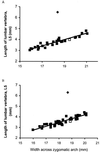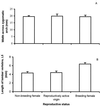Morphological castes in a vertebrate
- PMID: 11087866
- PMCID: PMC27201
- DOI: 10.1073/pnas.97.24.13194
Morphological castes in a vertebrate
Abstract
Morphological specialization for a specific role has, until now, been assumed to be restricted to social invertebrates. Herein we show that complete physical dimorphism has evolved between reproductives and helpers in the eusocial naked mole-rat. Dimorphism is a consequence of the lumbar vertebrae lengthening after the onset of reproduction in females. This is the only known example of morphological castes in a vertebrate and is distinct from continuous size variation between breeders and helpers in other species of cooperatively breeding vertebrates. The evolution of castes in a mammal and insects represents a striking example of convergent evolution for enhanced fecundity in societies characterized by high reproductive skew. Similarities in the selective environment between naked mole-rats and eusocial insect species highlight the selective conditions under which queen/worker castes are predicted to evolve in animal societies.
Figures


 ;
n = 10), adult nonbreeding females
(
;
n = 10), adult nonbreeding females
( ;
n = 10), and breeding males (□;
n = 6) from the same colonies.
;
n = 10), and breeding males (□;
n = 6) from the same colonies.
Similar articles
-
Morphological and genomic shifts in mole-rat 'queens' increase fecundity but reduce skeletal integrity.Elife. 2021 Apr 12;10:e65760. doi: 10.7554/eLife.65760. Elife. 2021. PMID: 33843584 Free PMC article.
-
Morphological divergence of breeders and helpers in wild Damaraland mole-rat societies.Evolution. 2010 Nov;64(11):3190-7. doi: 10.1111/j.1558-5646.2010.01066.x. Evolution. 2010. PMID: 20561049
-
Workload distribution in wild Damaraland mole-rat groups.Philos Trans R Soc Lond B Biol Sci. 2025 Mar 20;380(1922):20230276. doi: 10.1098/rstb.2023.0276. Epub 2025 Mar 20. Philos Trans R Soc Lond B Biol Sci. 2025. PMID: 40109115 Free PMC article.
-
Plasticity and constraints on social evolution in African mole-rats: ultimate and proximate factors.Philos Trans R Soc Lond B Biol Sci. 2013 Apr 8;368(1618):20120347. doi: 10.1098/rstb.2012.0347. Print 2013 May 19. Philos Trans R Soc Lond B Biol Sci. 2013. PMID: 23569295 Free PMC article. Review.
-
Stress in an underground empire.Biol Lett. 2022 Mar;18(3):20220012. doi: 10.1098/rsbl.2022.0012. Epub 2022 Mar 30. Biol Lett. 2022. PMID: 35350874 Free PMC article. Review.
Cited by
-
Testicular Structure and Spermatogenesis in the Naked Mole-Rat Is Unique (Degenerate) and Atypical Compared to Other Mammals.Front Cell Dev Biol. 2019 Oct 16;7:234. doi: 10.3389/fcell.2019.00234. eCollection 2019. Front Cell Dev Biol. 2019. PMID: 31681767 Free PMC article.
-
Housing and Husbandry Alternatives for Naked Mole Rat Colonies Used in Research Settings.J Am Assoc Lab Anim Sci. 2022 Sep 1;61(5):412-418. doi: 10.30802/AALAS-JAALAS-22-000035. Epub 2022 Aug 9. J Am Assoc Lab Anim Sci. 2022. PMID: 35944976 Free PMC article.
-
Sperm structure and motility in the eusocial naked mole-rat, Heterocephalus glaber: a case of degenerative orthogenesis in the absence of sperm competition?BMC Evol Biol. 2011 Dec 5;11:351. doi: 10.1186/1471-2148-11-351. BMC Evol Biol. 2011. PMID: 22142177 Free PMC article.
-
The Idiosyncratic Physiological Traits of the Naked Mole-Rat; a Resilient Animal Model of Aging, Longevity, and Healthspan.Adv Exp Med Biol. 2021;1319:221-254. doi: 10.1007/978-3-030-65943-1_8. Adv Exp Med Biol. 2021. PMID: 34424518 Review.
-
Neuroendocrinology and sexual differentiation in eusocial mammals.Front Neuroendocrinol. 2009 Oct;30(4):519-533. doi: 10.1016/j.yfrne.2009.04.010. Epub 2009 May 4. Front Neuroendocrinol. 2009. PMID: 19416733 Free PMC article. Review.
References
-
- Wilson E O. The Insect Societies. Cambridge, MA: Harvard Univ. Press; 1971.
-
- Michener C D. The Social Behavior of Bees. Cambridge, MA: Harvard Univ. Press; 1974.
-
- Jarvis J U M, O'Riain M J, Bennett N C, Sherman P W. Trends Ecol Evol. 1994;9:47–51. - PubMed
-
- Gotwald W H. Army Ants: The Biology of Social Predation. Ithaca: Cornell Univ. Press; 1995.
-
- Noirot C. In: Social Insects: An Evolutionary Approach to Castes and Reproduction. Engels W, editor. Berlin: Springer; 1990. pp. 5–35. - PubMed
Publication types
MeSH terms
LinkOut - more resources
Full Text Sources

